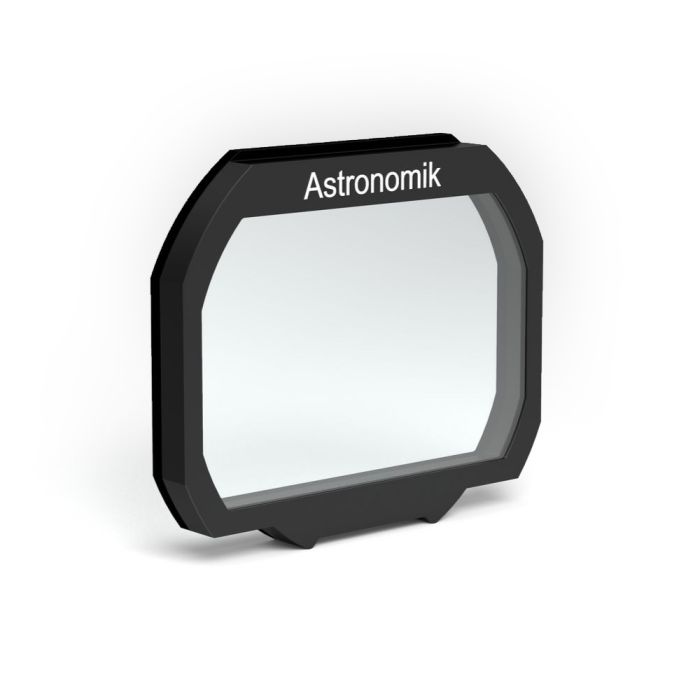Astronomik L-1 UV-IR Blocking Sony Alpha 7 Clip Filter
Astronomik UV-IR Blocking Luminance Filters
For an exceptional final image, the Luminance channel is probably the most crucial. The filter should feature the highest possible transmission with a wide spectral bandpass so you get as much signal as is viable. This combination enables impressive sensitivity and provides you with the greatest pixel photon counts. While the high transmission level is an excellent feature of Astronomik's new Luminance filters, not all optical instruments, or supplemental optical devices such as correctors, field flatteners, or reducers, enjoy perfect color correction. Thus the Luminance filter's spectral bandpass width can be an issue. A band pass with too much width enables the transmission of light that is not completely focused (chromatic aberration), making stars display as soft or bloated. In such instances image processing can be challenging. Therefore, having a marginally narrower spectral window in your Luminance filter can lessen or even do away with this detrimental effect altogether.
Astronomik has updated their Luminance filter line to include three different spectral window widths so that you can match your L filter to the type of telescope you use. The "L-2" filter is very similar to the classic Astronomik Luminance filter. By contrast, the L-1 has a wider spectral window, while the L-3's spectral window is narrower.
The color correction of your telescope will determine whether you should use a filter with a wider spectral window for the Luminance data. For the widest spectral window, choose the L1 filter; and for the narrowest spectral window, choose the L3 filter. The middle ground contains the L2 which has about the same size spectral window as Astronomik's current L-Filter.
If your optical system is completely chromatic aberration free, you should get an L1 filter for your setup. For general use with most optical systems employing a corrector, flattener or reducer in the optical train, the L2 is optimal. The L3 filter is made for users with refractors that have less than ideal color correction. Plus, when used in conjunction with Astronomik's new Deep-Sky RGB filters, the L3 filter will reduce that annoying bluish halo around stars.
The transmission curve characteristics and coatings on the new Luminance filters have been designed and engineered in such a way that no halos or reflections will be visible. Even with bright stars in the field of view you will be able to reveal the faintest structures in galaxies or nebulae.
Like all Astronomik Filters, the new Luminance filters are made using an extremely durable and scratch resistant coating, deposited on the finest polished optical substrate, which is free of any striae or internal strains. All substrates are made to exactly the same thickness, so all Astronomik filters are parfocal.
Astronomik L-1 UV-IR Blocking Filter for Sony Alpha 7 Highlights
- Astronomik Sony Alpha 7 Clip Format UV-IR Blocking Filter for Mk1, Mk2, and Mk3 variants of Sony Alpha 7, 7r, 7r IV, and 7s camera models
- The luminance channel, perhaps the most important channel for achieving the best possible end results for astrophotography, is optimized by this Astronomik UV-IR Blocking Filter to provide enhanced sharpness, contrast, and low noise
- Parfocal with all other filters offered by Astronomik
- Fully resistant to scratching, aging, and high humidity
- Diffraction limited, this filter will not lower the optical performance level of your telescope
- Astronomik filters are delivered with a durable, superior quality plastic filter box
Astronomik Sony Alpha 7 Clip Filter System
Astronomik's exclusive Clip-Filter system is made from black anodized aluminum and laser-cut using ultra modern machinery. This filter can be directly inserted into the camera body of MkI, MkII, and MkIII versions of Sony Alpha 7, 7r, 7r IV, and 7s models in just seconds. No modifications are required and all lens functions such as focus, screen, and image stabilization, continue to be operational! In addition, this system also serves as a dust protector, preventing dust from accumulating on your sensor during long exposures.


